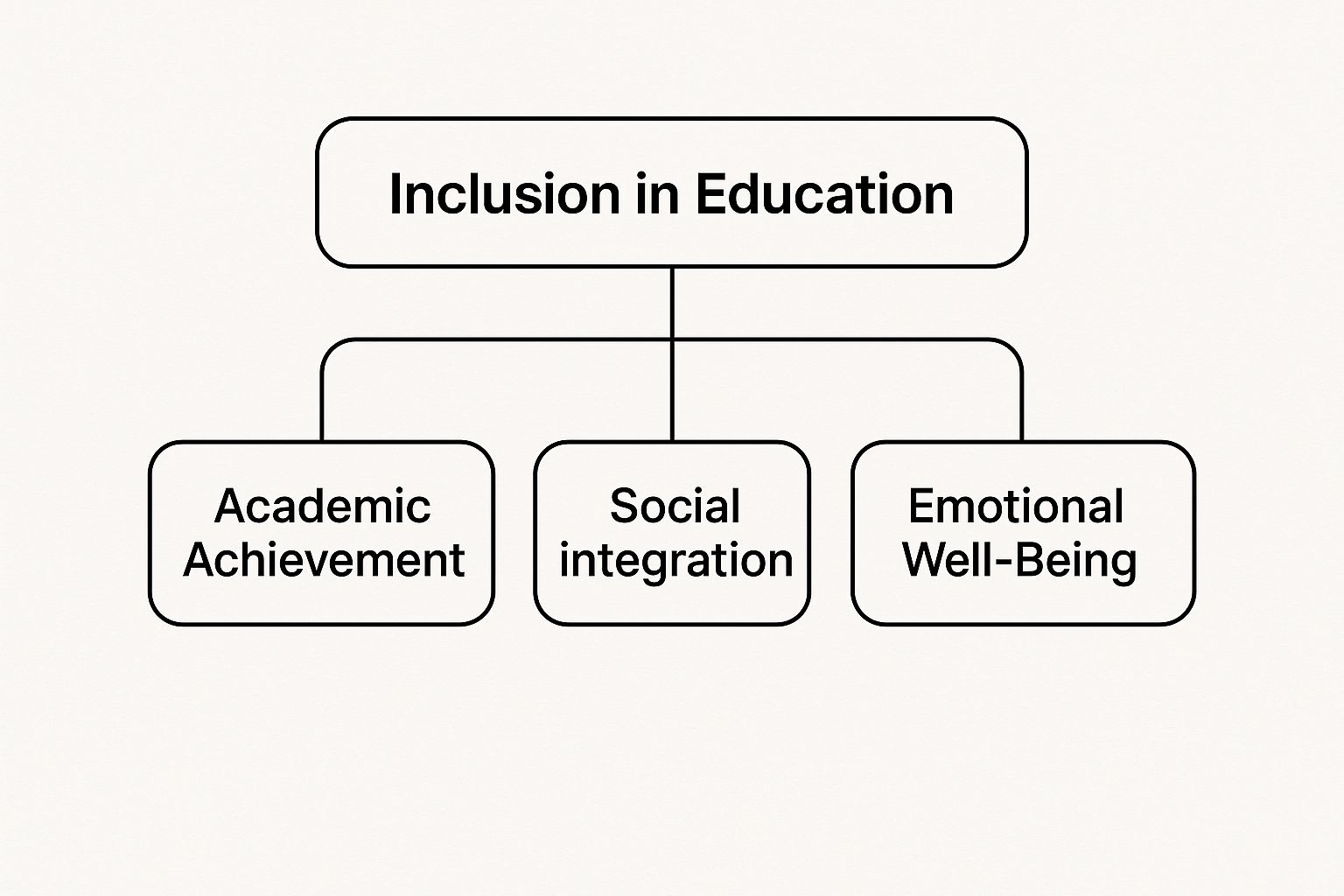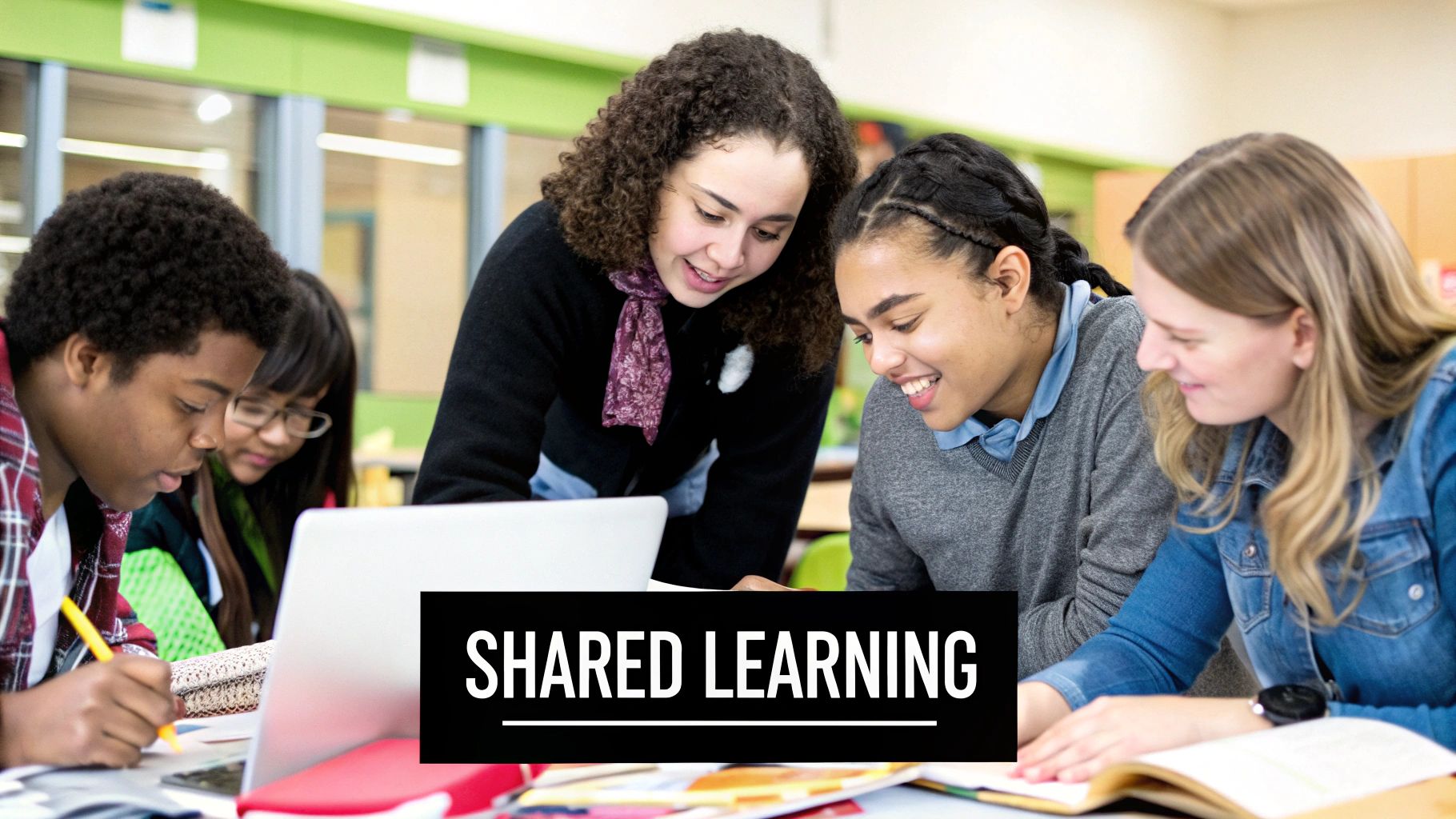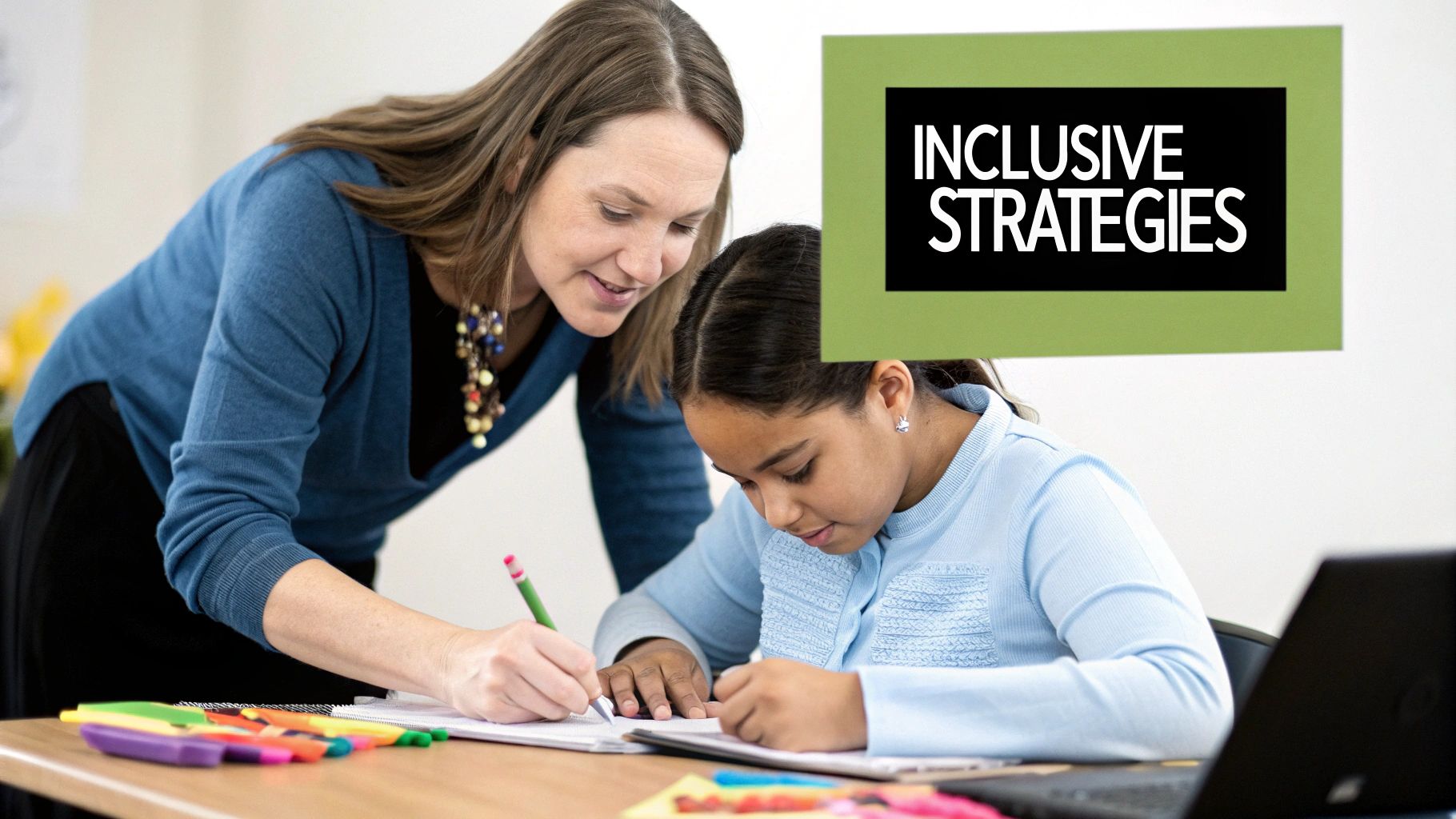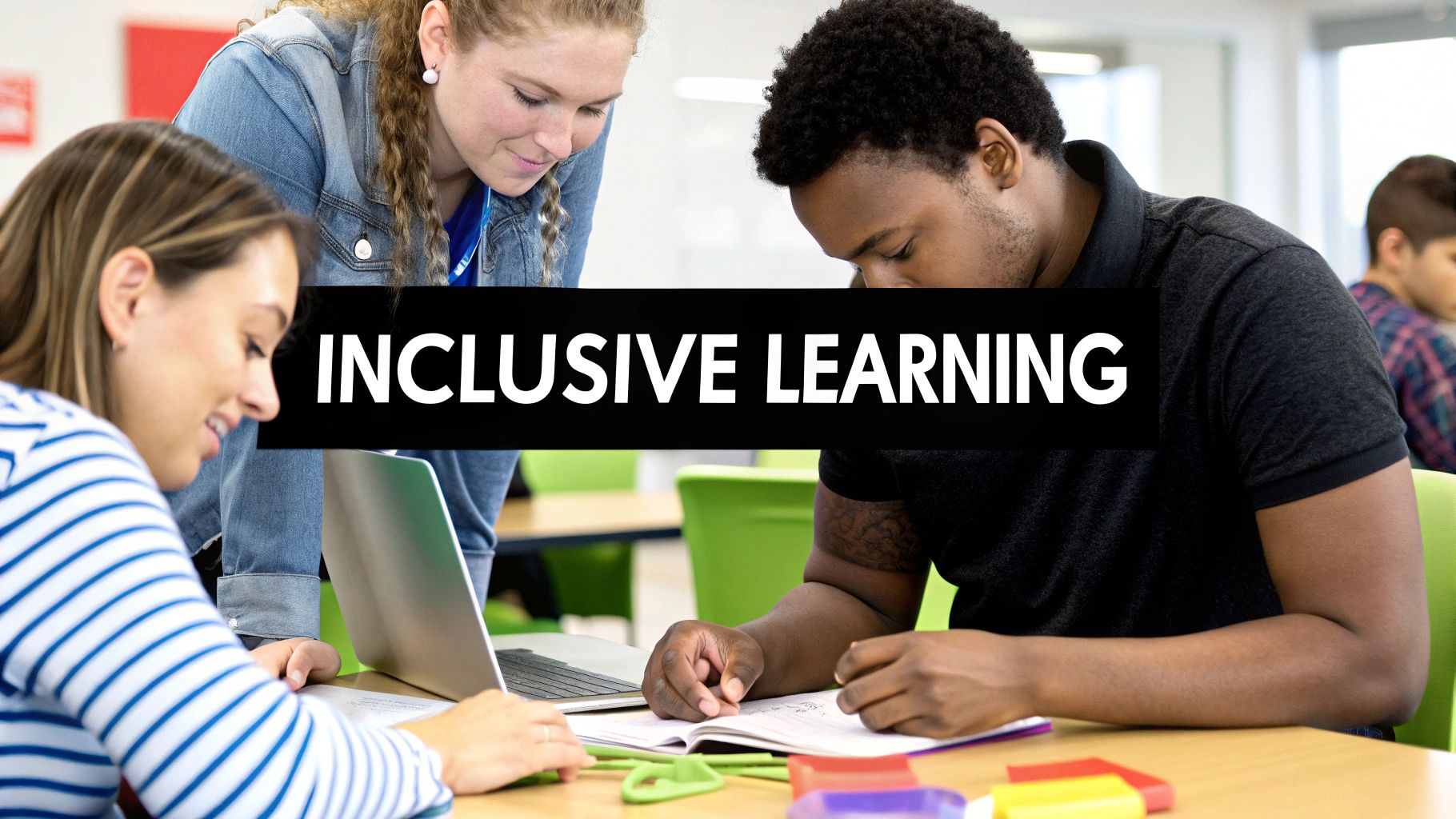Inclusion in education is about a fundamental promise we make to our children: that every single one of them will feel seen, valued, and essential to the school community. It’s a world away from just putting children with different needs in the same classroom. Imagine a child who feels a knot of anxiety in their stomach every morning because they know the lesson will move too fast for them. Inclusion is about intentionally redesigning that classroom so that child feels confident, supported, and ready to learn, right alongside their friends.
Understanding What Inclusion in Education Really Means
When parents first hear the word "inclusion," it can spark a mix of feelings. Hope, certainly, but also a little bit of worry. Will my child get the attention they need? Will they feel like they genuinely belong, or will they just be… there?
At its heart, understanding inclusion means shifting our perspective entirely. It’s not about asking a child to bend and break to fit into a rigid, one-size-fits-all system. It’s about the system itself becoming flexible enough to meet the unique needs of every single child.
Think of it like a garden. A good gardener doesn't give every plant the exact same amount of sunlight and water. An oak seedling needs different care than a delicate orchid, but both are vital to the beauty and balance of the garden. True inclusion works the same way. It recognises that each child has their own strengths, challenges, and ways of learning, and it provides the specific care they need to flourish. It’s about seeing the child who learns best through movement and giving them a hands-on project, not just a worksheet.
This approach is about creating a powerful sense of belonging. It’s the feeling a child gets when their teacher gets them—when they understand that loud noises are overwhelming, or that they need a quiet corner to focus. It’s when their classmates value their unique point of view, and when they know, without a doubt, they have a team cheering them on.
The Four Pillars of True Inclusion
A genuinely inclusive environment is built on the firm belief that diversity is a strength, not a problem to be solved. It’s about actively dismantling barriers to learning, whether they’re physical, academic, or social. This breaks down into four key areas that make a real difference to a child's day.
This table shows how these ideas move from a simple concept to something real and tangible for your child.
| Pillar | What It Means for Your Child | In Practice: A Child's Experience |
|---|---|---|
| Access | My child has the right to be in the classroom and use all learning resources. | A child with dyslexia is given access to audiobooks for a novel study, so they can participate fully in the class discussion without the stress of reading holding them back. |
| Participation | My child is actively encouraged to engage in lessons, discussions, and group activities. | During a science experiment, a non-verbal child is given a tablet with symbols to communicate their observations, ensuring their ideas are heard and valued by the group. |
| Support | Personalised help is available to overcome any barriers my child faces in their learning. | A child who struggles with anxiety has a designated 'safe space' in the classroom they can go to, and a teacher who checks in with them emotionally throughout the day. |
| Belonging | My child feels like they are a respected and integral part of the school community. | When celebrating holidays, the school includes Diwali, Hanukkah, and Eid alongside Christmas, so every child sees their family's culture recognised and celebrated. |
Ultimately, these four pillars ensure that inclusion isn't just a policy on a piece of paper but a lived, daily experience for every student.
This infographic helps visualise how inclusion supports the whole child, focusing on academic, social, and emotional growth all at once.

As the image shows, academic success is just one piece of the puzzle. A truly inclusive approach nurtures a child’s social skills and emotional resilience with just as much care.
Why This Matters More Than Ever
The drive for inclusive practices isn't just a nice idea; it reflects the reality of modern classrooms. In the UK, the number of pupils identified with Special Educational Needs and Disabilities (SEND) has been steadily rising.
As of January 2024, an estimated 20.5% of pupils in England have SEND, a significant figure that underscores the urgent need for adaptable and responsive learning environments. The data shows that 5.3% of pupils have a formal Education, Health and Care Plan (EHCP), while another 14.2% receive dedicated SEN Support within their schools. You can explore more data about the rise of SEND pupils in England and see what it means for schools today.
Inclusion is not a strategy to help people fit into the systems and structures which exist in our societies; it is about transforming those systems and structures to make it better for everyone. Inclusion is about creating a better world for everyone.
This philosophy takes us beyond simply tolerating differences and moves us toward actively celebrating each child's individuality. It’s a promise that every student will have the tools, encouragement, and community they need to reach their full potential—not in isolation, but as a vital and celebrated member of their school.
Why Every Child Thrives in an Inclusive Classroom
It’s a common misconception that an inclusive classroom is a space designed only to support children with Special Educational Needs and Disabilities (SEND). While that’s absolutely a vital part of its mission, the real magic of inclusion is that it creates an environment where every single child benefits. It’s a powerful force that lifts the entire learning community.

When a classroom truly welcomes diversity, it doesn't water down academic standards; it enriches them for everyone. The core truth about what is inclusion in education is that it's not a zero-sum game. The very strategies that help one child finally grasp a concept can unlock a completely new way of thinking for another.
For Children with Diverse Needs: A World of Opportunity
For a child who learns differently, an inclusive classroom is the key that unlocks their potential. It’s the difference between feeling constantly left behind and feeling capable and understood. Instead of being separated, they are immersed in a rich curriculum right alongside their peers, opening up far greater opportunities for both academic challenge and social growth.
Think about a student with dysgraphia who gets the option to create a video project instead of writing a long essay. This move doesn't just assess their knowledge of history; it empowers them to showcase their creativity and deep understanding without being held back by a specific barrier. They're no longer defined by their challenge but celebrated for their unique strengths. They get to feel the pride of creating something amazing, just like everyone else.
An inclusive environment ensures that a child’s educational journey is defined by their potential, not their limitations. It provides the personalised support and flexible pathways they need to not just keep up, but to truly flourish.
This child-centred approach means they have access to the same high expectations as everyone else, but with the right support to help them get there.
For Every Other Child: Building Skills for Life
The benefits for a child’s peers are just as profound, even if they aren't as obvious at first. Growing up in a diverse classroom is an invaluable education in itself, teaching essential life skills that you simply can't find in a textbook. It’s where a child’s heart and mind grow together.
When children collaborate with peers who have different abilities, backgrounds, and perspectives, they naturally develop crucial skills:
- Empathy and Compassion: They learn to see the world from another's point of view. For example, when they see a friend being given extra time on a test, they don't see it as "unfair"; they understand it’s what their friend needs to show what they know. This builds a genuine kindness that lasts a lifetime.
- Creative Problem-Solving: Working with a classmate who thinks differently forces them to find new ways to communicate, collaborate, and tackle problems together.
- Patience and Resilience: A child learns patience by helping a friend through a tricky maths problem and, in the process, reinforces their own understanding of the concept.
- Dismantling Prejudice: Direct, positive interaction with peers from all walks of life is the single most effective way to break down stereotypes and build a foundation of mutual respect.
These experiences shape children into more thoughtful, adaptable, and compassionate leaders of tomorrow. Understanding specific neurodevelopmental conditions is key to ensuring all students feel supported; for instance, educators often need to consider guidelines for navigating ADHD with clarity to foster this supportive atmosphere. For parents looking to help at home, exploring specific study techniques can also make a significant difference. You can learn more by exploring our guide on powerful study techniques for students with ADHD.
Ultimately, an inclusive classroom isn't about making compromises. It’s about creating a smarter, kinder, and more dynamic community where every child is challenged, supported, and learns that their unique voice matters.
The Reality of Inclusion in UK Schools
For any parent navigating the education system, the promise of inclusion is a powerful source of hope. In the UK, this promise is backed by important legal frameworks designed to protect every child's right to a mainstream education. Yet, as so many families know all too well, the journey from policy on paper to a child’s lived experience in the classroom can be fraught with challenges. The feeling of watching your child struggle without the right support is something no parent should have to endure.

This section takes an honest look at where we are with inclusive education today. It’s about celebrating the incredible progress made while also validating the very real concerns and frustrations that parents often feel. Understanding this gap between intention and reality is the first step toward advocating effectively for your child.
The Commitment to Mainstream Education
The UK’s approach to inclusion is built on a simple but profound principle: wherever possible, children with Special Educational Needs and Disabilities (SEND) should learn alongside their peers in mainstream schools. This isn't just a hopeful idea; it's a statistical reality.
The vast majority of children with identified needs are learning within the same school gates as their friends and neighbours. For instance, recent data shows a significant number of pupils with SEND are on SEN Support, a framework where mainstream schools are primarily responsible for providing resources. This reflects a deep commitment to the inclusive model, with the number of pupils on SEN Support increasing by a staggering 45,000 in just one year.
But this is where the picture gets complicated. The effectiveness of this support is where many parents' worries begin. Many pupils with SEND fall behind their peers in key subjects like reading and writing, often because specialised teaching is spread too thin in these mainstream settings. You can read more about the latest SEND statistics in England to get a clearer sense of the national picture.
For many parents, the core question isn't whether their child can be present in a mainstream classroom, but whether they can truly participate and thrive there. The gap between presence and participation is where the real work of inclusion lies.
This highlights a fundamental tension. While the system is structured for inclusion, the resources, training, and specialist support needed to make it truly work for every single child are often stretched to breaking point.
Common Challenges Parents and Schools Face
When a child isn't flourishing, it’s rarely down to a lack of care from their teachers. More often than not, the challenges are systemic, creating hurdles that both families and educators are forced to navigate together.
Some of the most common difficulties that directly impact a child's experience include:
- Overstretched Resources: For a child, this feels like never being able to get the teacher's attention when they're stuck. Large class sizes and tight budgets make it incredibly difficult for even the most dedicated teacher to provide the individualised attention a child needs.
- Lack of Specialised Training: This means a teacher might not understand why a child with autism finds eye contact difficult, or might mistake an ADHD-related behaviour for deliberate disruption, leading to frustration for both teacher and child.
- The "One-Size-Fits-Most" Curriculum: A rigid curriculum can be soul-crushing for a child who learns differently. A creative, hands-on learner may feel like a failure if their only option to show their knowledge is a written exam, even if they understand the topic perfectly.
- Social and Emotional Hurdles: A child might feel isolated at lunchtime or misunderstood by their peers. Without proactive support to build social skills and friendships, they can feel desperately lonely even when they are physically in the room.
These issues take a huge emotional toll on families. It’s draining to feel like you’re in a constant fight for the right support for your child, explaining their needs over and over, only to watch them struggle in an environment that isn’t set up for them to succeed.
Acknowledging these realities isn't about placing blame. It’s about building a foundation of trust and understanding. By seeing the system for what it is—full of good intentions but also significant challenges—we can better prepare to find practical, child-centred solutions that truly work.
Practical Strategies for an Inclusive Learning Space
Understanding the heart of inclusive education naturally leads to the most important question for any parent or educator: How do we make it happen? Shifting from the big ideas to day-to-day actions is where a child’s world can truly change. The goal isn’t to find a single magic bullet, but to build a toolkit of flexible, child-first strategies that create multiple pathways for every student to succeed.
These strategies are proactive, not reactive. They’re about designing learning experiences that are accessible and engaging from the very beginning, rather than trying to retrofit a rigid lesson plan for a child who is already struggling. It’s about building a space where every learner feels empowered, not just accommodated.
Universal Design for Learning
One of the most powerful approaches is Universal Design for Learning (UDL). Think of it like a builder installing ramps and automatic doors in a new building. These features are essential for a wheelchair user, but they also make life easier for a parent with a pram, a delivery person with a trolley, and someone on crutches. The design helps everyone.
UDL applies this same principle to the classroom. Instead of creating a single lesson and then trying to adapt it for different children, a UDL approach offers multiple ways for students to learn from the outset.
A history lesson on the Roman Empire, for example, could be designed with a child's needs at the centre:
- Multiple ways to learn the material: A child who is a visual learner could watch an engaging documentary. A kinaesthetic learner could explore an interactive 3D model of the Colosseum online. A child who struggles with focus might benefit from a podcast they can listen to in short bursts.
- Multiple ways to show what they know: To demonstrate their understanding, a child might choose to write a traditional essay, create a multimedia presentation, build a physical model, or write and perform a short play. A shy child might prefer to record their presentation at home rather than speak in front of the class.
This flexibility puts the child at the centre. It acknowledges that there isn't just one "right" way to learn and allows students to use their unique strengths to connect with the material and feel successful.
Differentiated Instruction
Flowing naturally from UDL is the concept of differentiated instruction. While UDL is the broad architectural plan for the classroom, differentiation is the teacher’s specific response to the individual needs of the children within it. It’s about tailoring the content, process, and assessment to match a student’s readiness and learning style.
This doesn't mean creating 25 different lesson plans. Instead, it involves making thoughtful adjustments. For example, in a maths lesson on fractions, a child who finds the concept abstract might be working with physical pizza slices to grasp the core idea. Another child who is confident with fractions might be tackling advanced challenges that apply them to a recipe, while another gets one-on-one time with the teacher to go over the basics again.
The essence of differentiation is meeting children where they are and helping them move forward. It’s a promise that no child will be left behind because the pace is too fast, nor held back because it’s too slow.
Co-Teaching and Specialist Support
Creating this kind of dynamic learning environment is a huge task for one teacher alone. That's why collaborative models like co-teaching are so effective. This is where a mainstream teacher and a special education specialist plan and teach lessons together in the same classroom. For a child, this means there are two supportive adults in the room, doubling their chances of getting help right when they need it.
However, access to such specialised support remains a significant challenge. The UK government's push to ensure more specialist teachers are available in mainstream schools is a critical step forward. Currently, many children with SEND receive primary support from teaching assistants rather than teachers with specialised training, which contributes to pupils with SEND being, on average, two years behind in writing by the end of primary school.
To foster a truly inclusive environment, educators can adapt diverse pedagogical approaches and explore engaging actionable art lesson ideas for elementary teachers, ensuring every child finds a way to express themselves and learn. These strategies, from UDL to stronger specialist support, are the practical building blocks of a classroom where every child doesn’t just fit in, but truly belongs.
How We Put Inclusion into Practice at Queens Online School
Knowing the theory behind an inclusive classroom is one thing; seeing it brought to life is what really matters. For many families, the daily reality in a traditional school doesn’t always match the inclusive ideal. At Queens Online School, we’ve built our entire educational model around putting these principles into direct, meaningful action every single day.
It all comes down to a simple, powerful belief: a child’s education should be built around them, not the other way around. We want to show you exactly how our philosophy translates into a supportive, thriving learning environment for your child. It’s not just about what we teach, but how we create a space where every student feels seen, heard, and ready to succeed.
Small Classes, Big Connections
One of the biggest hurdles to genuine inclusion in a mainstream school is class size. It's nearly impossible for one teacher to give deep, personalised attention to a room of thirty children. That’s why we intentionally keep our live, interactive classes small—it’s the cornerstone of our entire approach.
This isn't just about a better student-to-teacher ratio; it’s about creating real human connection. In a small class, our teachers know each child as an individual. They learn their unique personality, their academic strengths, and the specific areas where they might need a bit more encouragement. For a child, this means their teacher notices when they are having a tough day or celebrates the small victories that might go unseen in a bigger classroom.
In such an intimate setting, there’s nowhere for a child to hide or get lost in the crowd. Every student is seen, their contributions are valued, and our teachers can spot the exact moment a child is struggling and offer support immediately—not weeks later on a report card.
A Curriculum That Reflects Every Child
True inclusion means a child sees themselves and the wider world reflected in what they learn. A rigid, one-note curriculum can easily make children from diverse backgrounds or with different ways of thinking feel invisible. Our curriculum is designed from the ground up to be broad, balanced, and rich with diverse perspectives.
For instance, when studying literature, we don’t just stick to the traditional canon. We introduce our students to authors from all over the world, with characters that reflect a wide range of experiences. This means a child might read a story about a family that looks and sounds just like theirs, making them feel recognised and valued.
Our goal is for every child to feel that their story is part of the larger human story. When a curriculum is truly inclusive, it doesn’t just teach facts; it builds a powerful sense of belonging and validates every child's identity.
Adaptive Technology That Puts the Child in Control
In our classrooms, technology is never a gimmick. It’s a powerful tool for personalisation. We use adaptive learning platforms that intelligently adjust to your child's individual pace, which is a game-changer for inclusive learning.
Imagine a child who flies through maths but finds writing more of a challenge. Our technology lets them forge ahead with advanced mathematical concepts while receiving extra support and practice in essay structure—all without feeling singled out or held back. This empowers them by giving them control over their own learning.
This gives students a few key advantages:
- A Personalised Pace: Children can spend more time on topics they find tricky and move more quickly through material they’ve already mastered, reducing frustration.
- Immediate Feedback: The platforms offer instant feedback, helping students learn from their mistakes in the moment and build confidence without waiting for a teacher's red pen.
- Reduced Anxiety: By removing the pressure to "keep up" with everyone else, students can focus on their own learning journey, which reduces stress and builds academic self-esteem.
The Story of Finding a Voice
Let me tell you about a student we’ll call Leo. In his previous school, the noisy, bustling environment was completely overwhelming for him. He was a bright, creative boy, but he rarely spoke up in class, and his confidence took a real hit. His parents felt heartbroken watching him fade into the background.
When Leo joined Queens Online School, the change was remarkable. In the calm, focused environment of his small online class, he started to participate. He used the chat function at first, then slowly began raising his virtual hand to share his ideas. His teachers, all trained in inclusive methods, celebrated his contributions and gave him the space he needed to feel comfortable.
Before long, Leo was leading group projects and helping his classmates. He wasn't a different child; he was the same brilliant boy, finally in an environment built to let him shine. This is what inclusion looks like in action. It’s about creating the right conditions to unlock every child’s potential, and we make it happen through a constant partnership with parents, specialist teacher training, and an unwavering commitment to putting each child’s emotional and academic well-being first.
Common Questions About Inclusion in Education
Stepping into the world of inclusive education naturally brings up some heartfelt, practical questions. As a parent or carer, you want to be certain you're making the best choice for your child's happiness and future. Here, we'll tackle some of the most common concerns we hear, offering straight-talking answers that put your child’s needs first.

Will an Inclusive Classroom Slow Down My Child's Learning?
This is a very common and completely understandable worry. The fear is that by accommodating some children, others might get held back. But in reality, a well-resourced and properly managed inclusive classroom often does the opposite—it can enrich the learning experience for everyone.
Teachers in these settings use a whole toolkit of strategies, like Universal Design for Learning (UDL), which offers multiple ways to engage with any given topic. This means that while one child might be getting targeted support on a foundational concept, another could be tackling an advanced extension project on the exact same subject. For example, a high-flying student in English might be challenged to write a sonnet, while another student works on mastering sentence structure. Both are growing at their own pace.
The focus shifts from a rigid, one-size-fits-all pace to celebrating each child's individual progress. More importantly, this environment teaches skills that go far beyond academics. It shows all children how to be patient, solve problems creatively, and collaborate with people who think differently—invaluable skills for life.
What Is the Difference Between Inclusion and Integration?
These two words sound similar, but they represent fundamentally different philosophies, especially when it comes to a child's day-to-day experience. Getting your head around the distinction is key to understanding what inclusion in education really means at its core.
Integration is about placing a child with special educational needs into a mainstream classroom and expecting them to adapt to the existing system. The child has to do all the work to fit in.
Inclusion, on the other hand, is a complete shift in mindset. It means the system itself is designed from the ground up to be flexible and supportive for every single learner from the start. The school does the work to fit the child.
Think of it this way: integration is like being invited to a party but finding the music is too loud, you can't eat any of the food, and no one talks to you. You're physically there, but you don't feel like you belong. Inclusion is like helping to plan the party from the beginning, making sure your favourite songs are on the playlist and there are snacks you love. It’s the difference between simply being present and truly belonging.
How Can I Advocate for Better Inclusion for My Child?
Standing up for your child can feel daunting, but your voice is incredibly powerful. The most effective approach is always rooted in positive, collaborative communication. You know your child better than anyone.
A great first step is to request a meeting with your child’s teacher and the school's SENCO (Special Educational Needs Coordinator). Coming prepared is your greatest ally.
- Gather specific examples: Jot down your child's strengths and the specific areas where they're facing challenges. Instead of saying, "He's struggling with writing," try, "He has wonderful ideas for stories, but when he tries to write them down, he gets very frustrated and gives up. What can we do to help him capture those amazing ideas?"
- Ask collaborative questions: Frame the conversation around teamwork. Questions like, "How can we work together to help my child thrive in your classroom?" or "What strategies have you found most effective for learners like mine?" open the door for a real partnership.
- Know your child’s rights: Get familiar with the basics of the UK's SEND Code of Practice and the Equality Act 2010. This knowledge empowers you to ask for the right kind of support.
Creating a detailed support plan can be a crucial step. It's worth looking at some helpful Individualised Education Plan examples to understand what these documents can look like and how they help structure a child's support system. A positive, informed, and persistent approach is your strongest tool in ensuring your child gets the education they truly deserve.
At Queens Online School, we believe every child deserves an education that celebrates who they are and empowers them to succeed. Our small class sizes, specialist teachers, and personalised learning paths are all designed to create a truly inclusive environment where every student can flourish.
Discover how we can support your child's unique journey today.

